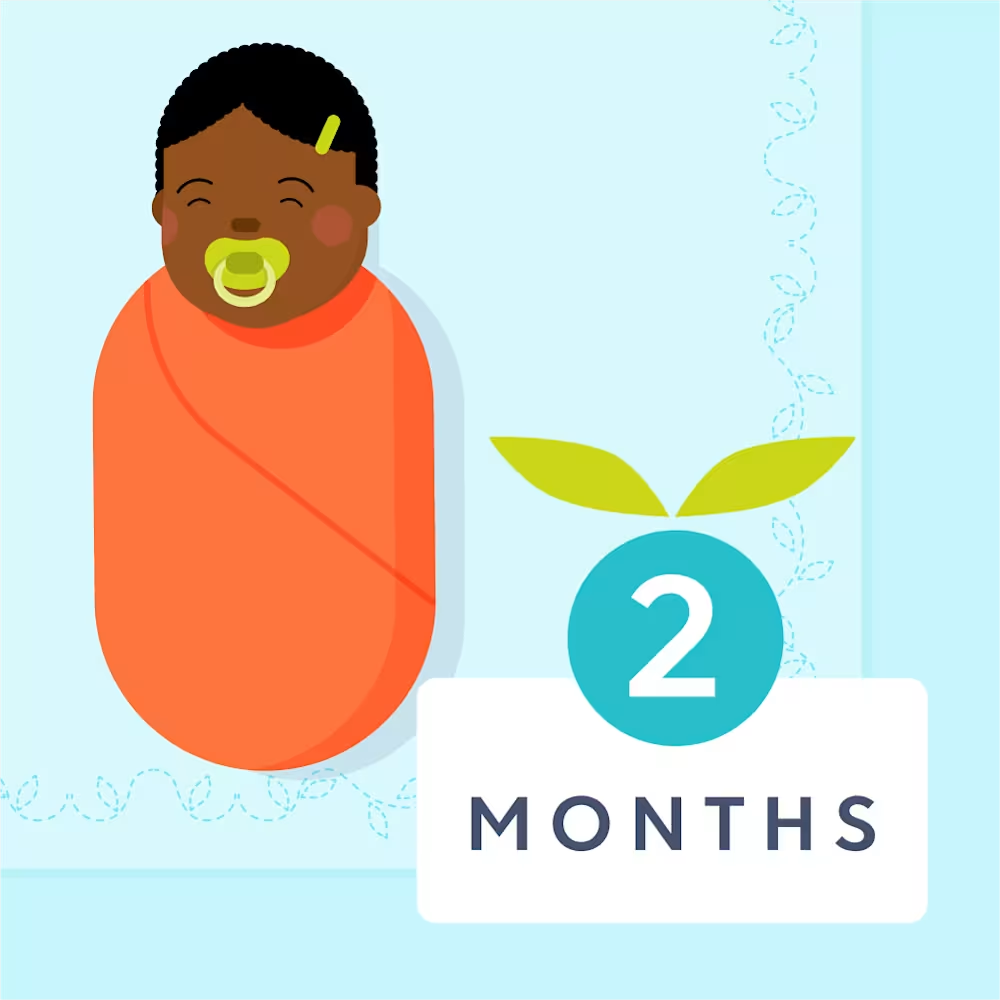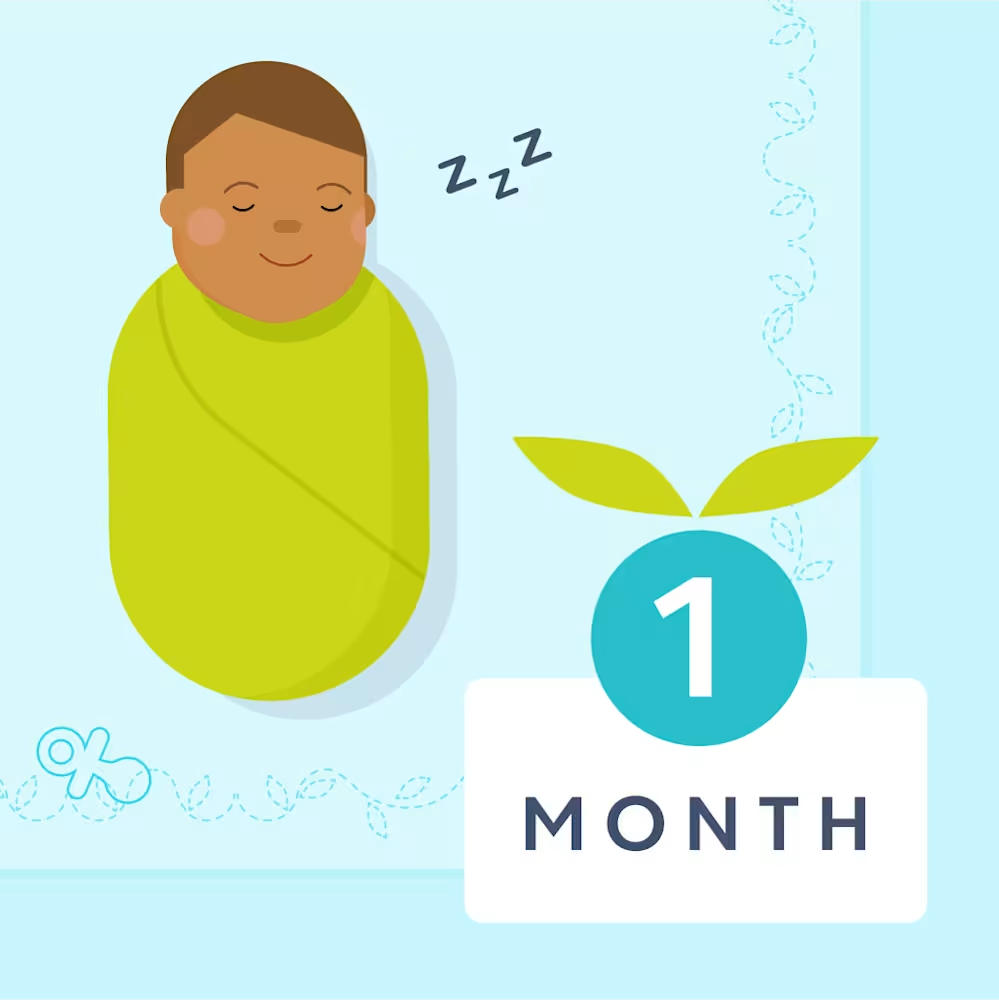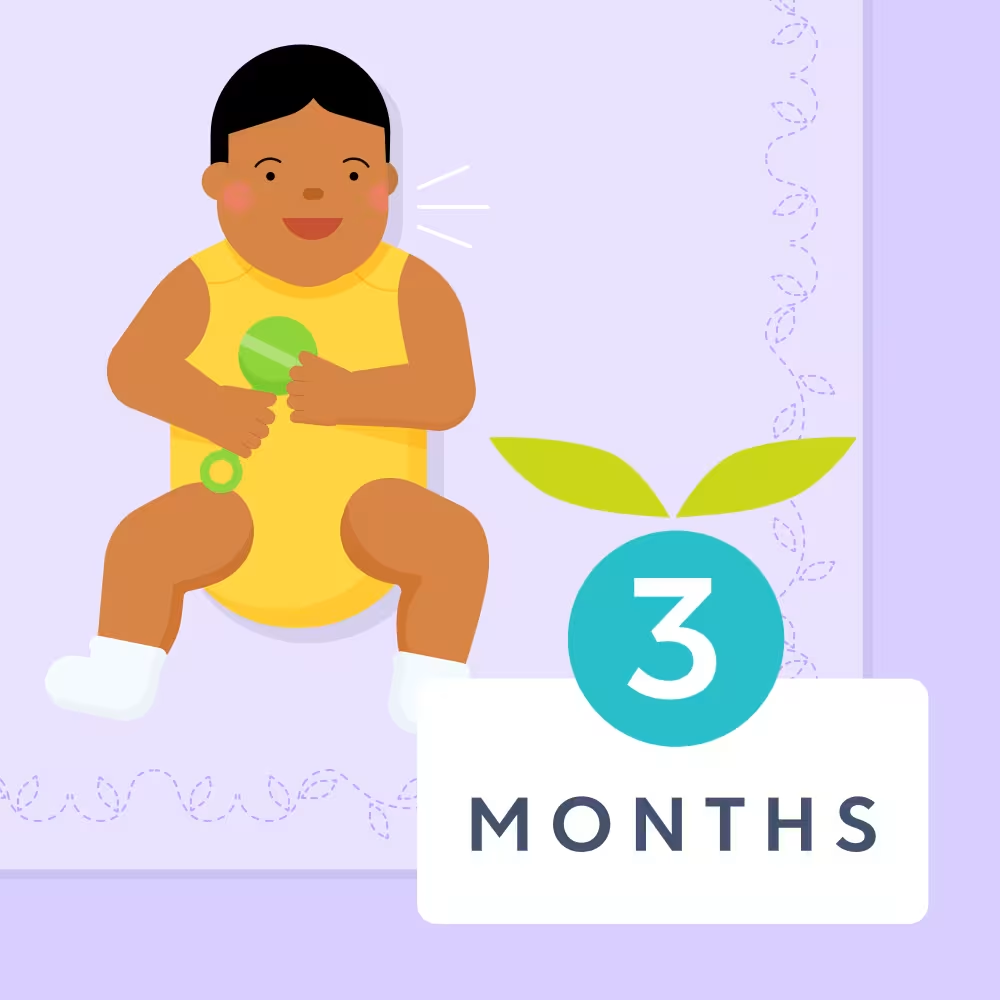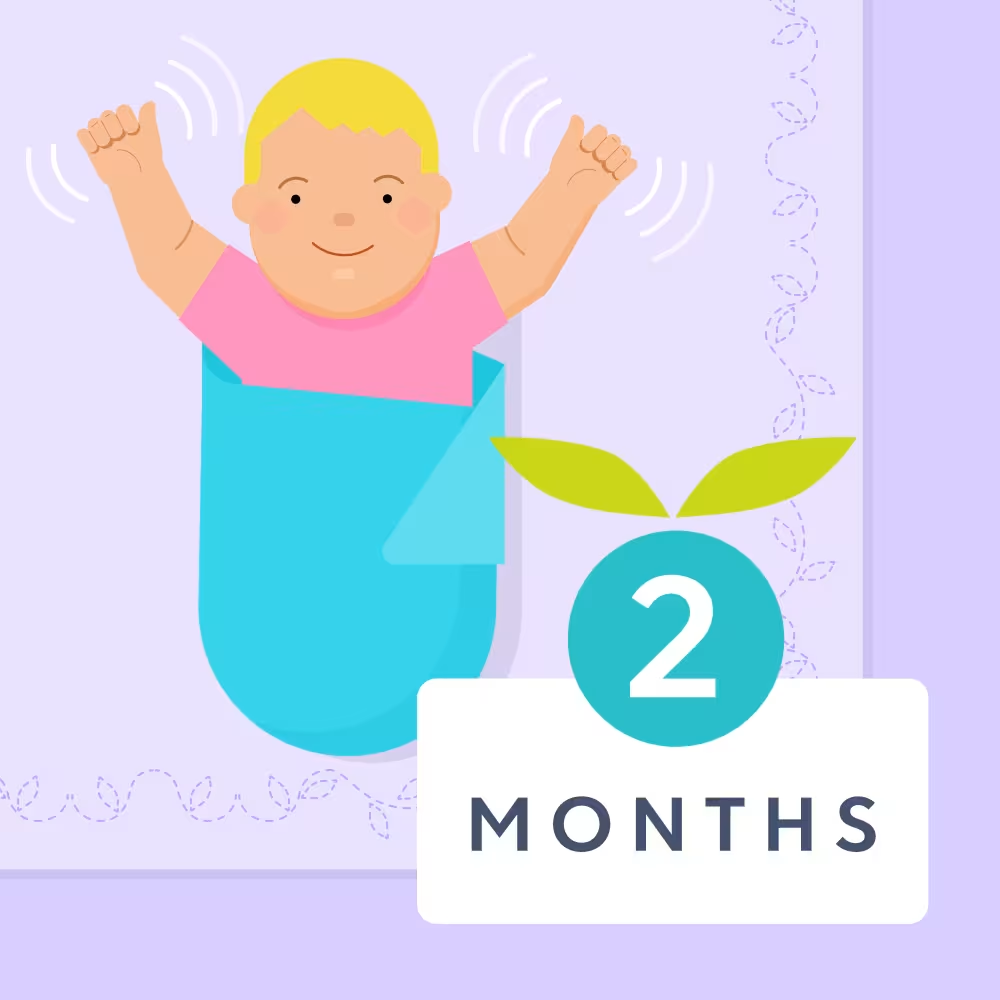1 month old baby milestones: Development, growth, and more
Updated Dec 29, 2025

In those first few weeks of your baby’s life, your days will likely be filled with feeding, changing, and snuggling your little one. It’s a period that can feel like you’re both doing so much yet nothing at all! But rest assured you’re doing the right things to support your newborn as they get used to the big, wide world outside the womb. While the changes are subtle, babies at 1 month learn and grow every day with your help.
In this article, we’ll go over the milestones you can expect from 0 - 4 week old babies, supply you with a useful 1 month old development checklist, and suggest handy tips to help ensure your little one is learning and growing as much as possible.
Editor's note
When we discuss babies and development at Huckleberry, we use their adjusted age (vs. actual age). There’s a wide spectrum when it comes to how fast babies grow and develop. Not all babies will reach 1 month old milestones at the same time — and that’s expected. While many infants do reach these milestones between 0 and 4 weeks, this isn’t always the case. If you have any concerns or questions about your child’s development, reach out to their pediatrician.
Table of Contents
1 month old baby milestones at a glance
Development:
Babies at 1 month spend most of their time eating and sleeping — this is normal! They’re not quite ready for major physical milestones like rolling over or sitting up. Instead, they’re doing age-appropriate skills like lifting their head briefly during tummy time, bringing their hands close to their mouth and eyes, and taking in the sights and sounds around them.
At this age, babies can focus on objects around 8 - 12 inches [] away and can’t see most colors just yet. However, they are starting to recognize familiar sounds and voices!
Sleep:
Newborn babies from 0 - 4 weeks sleep a lot. You may feel like all you do is feed your baby then change their diaper and it’s time for another nap. And commonly, it is! At this age, babies only typically stay awake for about so there’s quite a lot of daytime sleep.
Overall, we expect around 15.5 hours of total sleep in a 24-hour period. These numbers are general guidelines, however. Baby sleep needs vary and there’s a broad range of what’s normal and healthy. On top of that, newborn sleep can be pretty unpredictable and chaotic in those early weeks. Babies won’t follow a typical 24-hour schedule for sleeping and eating until closer to . Until then, nap schedules and durations are likely to vary greatly. Your little one may sleep for 10 minutes or two hours — you never really know!
What you can start to predict are your little one’s sleepy cues Signs your baby may be ready for sleep include yawning, irritability, and getting a glazed/faraway look. It may take a little practice to recognize these signals, but rest assured you’ll learn your baby’s cues before you know it! Recognizing signs that your infant is ready for sleep can help prevent them from becoming overtired. Overtired babies usually have a harder time falling asleep and staying asleep.
Even if you avoid the overtired stage, we don’t expect 1 month olds to . Young babies often need to wake overnight for feedings and comfort. It’s best to check in with your child’s pediatrician or a lactation consultant to determine how many nighttime feedings your child needs. Typically night feedings will continue until a baby has established a pattern of consistent weight gain, is back to birth weight, and has been cleared by a doctor or lactation consultant.
Although newborns aren’t ready for sleep plans and schedules quite yet, you can begin setting your little one up for success by getting into a good sleep routine now. You can start by using the Huckleberry app to track your baby's naps and bedtimes. This will allow you to see how they change as they grow too. If you’re looking for some expert-backed sleep support now or in the future, check out membership in the app.
Feeding:
? Similar to sleep, newborns likely won’t have a consistent feeding pattern for a while. It’s normal for a little one’s eating schedule to vary frequently at this stage. The for a newborn is usually every 2 - 3 hours, which is about 8 - 12 breast milk or formula feedings in a 24-hour period. Little ones will wake to feed often during these first few months and require regular feedings day and night to keep their energy levels up and hydrated.
The AAP recommends “responsive feeding” [] or feeding on demand for newborns. This means following your baby’s hungry and full cues and promptly responding. It’s ideal to initiate a feeding when your baby is first hungry [], before they start crying. Crying is a late hunger cue and it’s often much harder to feed a fussy baby []. If this happens, you may need to first calm your little one with snuggles, rocking, singing, and/or a pacifier, etc., then start a feed.
While figuring out your little one’s hunger cues may sound a little daunting, trust your instincts and watch for some telltale signs. Some ways [] your baby may let you know they’re hungry at this age include moving their hands to their mouth, making sucking noises or motions, rooting, and flexing arms and legs. Fullness cues may include starting and stopping feeding often, unlatching if breastfeeding, slowing down or falling asleep, or turning away from the bottle or breast.
It’s also common for newborns to engage in , which means shorter, more frequent feedings. Cluster feeding can boost your little one’s health and is often associated with growth spurts. If you’re breastfeeding, it can also stimulate milk production.
A period of cluster feeding can be physically and emotionally draining, but rest assured that it is normal and this phase won’t last forever. Consider reaching out to your child’s doctor or a lactation consultant if you have concerns about your newborn’s feeding patterns or your milk supply if you’re breastfeeding.
Phyiscal growth:
It’s common for babies to lose weight [] in their first few days of life, then over the next couple of weeks they usually catch up and surpass their birth weight then continue to steadily gain weight. Typically babies gain about one ounce per day after the first two weeks. They usually grow 1 - 1.5 inches [] in height too during their first month. It’s common for newborns to go through growth spurts at around 7 - 10 days old and again at 3 and 6 weeks old.
Note that some babies will grow more and some will grow less than this over their first month of life. At well-baby visits, your child’s doctor will ask you about their feeding habits and chart their height and weight to check that their physical growth is progressing. This can pinpoint any trends that may need attention. If you have concerns about your baby’s feeding, consult their pediatrician.
1 month old development milestones
Physical development
Gross motor milestones
Hand and arm movements: 1 month gross motor milestones likely include your newborn making jerky movements with their arms. They may be able to bring their hands [] close to their eyes and mouth at this stage, but their hand-eye coordination [] has not quite developed yet. Babies at 1 month often keep their hands in tight fists and may suck on their fists or fingers.
Head movements: Young babies need lots of support to keep their heads from flopping backward. They may be able to momentarily hold their head up when supported at 1 month old. Newborns can also move their heads from side to side [] and raise it up [] slightly while lying on their stomachs.
Sensory skills and development
Sight development
Focus: Babies at this age can focus on objects about 8 - 12 inches [] away. Their eyes typically wander and it’s normal for them to occasionally cross.
Visual preferences: Newborns at 1 month often prefer black-and-white images and high-contrast patterns. They can detect light and dark [], but can’t see all colors just yet. Most of all, they love human faces [] and facial expressions as their cognitive development is just beginning!
Hearing development
Reaction to sounds: At 1 month, a baby’s hearing is fully mature []. They may recognize certain sounds and turn toward familiar sounds and voices.
Smell development
Smell preferences: Babies at 1 month prefer sweet smells and avoid bitter or acidic smells. They can also recognize the scent of their mother’s breast milk [].
Touch development
Touch preferences: Young babies tend to prefer soft items [] (toys, clothing, etc.) and gentle touch. Snuggling [], swaddling, and “wearing” your baby in a sling or carrier can give them a sense of security. They usually dislike course textures and rough or abrupt handling.
Taste development
Taste preferences: Did you know taste buds begin forming in utero? Newborns have a strong preference for sweet tastes over sour or bitter. Remember babies should only eat breastmilk and/or formula at this age. The American Academy of Pediatrics [] recommends introducing water and solid foods at around 6 months old.
Newborn reflexes
Many of a newborn baby’s movements are done by reflex, meaning they happen automatically without your little one trying. Reflexes are normal and these innate skills help babies survive []! The presence and strength of a little one’s reflexes are an indication that their nervous system is working and developing properly. Not all newborns will acquire and lose reflexes at the same time, but there are general guidelines [] for what you can expect.
Root reflex
You may have noticed that your baby will turn their head and open their mouth (“root”) when the corner of their mouth is touched. This is a reflex! [] The root reflex helps newborns find the breast or bottle and usually disappears around 4 months old.
Suck reflex
This is another oral reflex that helps your baby eat in those early days. It causes a baby to suck when the roof of their mouth is touched with the breast or bottle nipple. This reflex begins to develop [] around the 32nd week of pregnancy and is fully matured by about 36 weeks, which is why premature babies may have a weak sucking ability — the reflex hadn’t quite developed yet.
Moro reflex
If you’ve seen your little one respond to a loud sound or movement by throwing their head back while their arms and legs flail out and then relax, then you’ve witnessed the Moro reflex (also called the startle reflex). This protective reflex typically starts to disappear [] at around 12 weeks and is usually fully gone by around 6 months.
Palmar grasp reflex
The palmar grasp reflex [] causes your little one to close their fingers when you stroke the palm of their hand. This often causes your baby to hold onto your finger, making for an adorable moment even if it’s not exactly intentional or a true fine motor skill. This reflex generally disappears around 5 - 6 months.
Stepping reflex
This reflex causes your little one to make walking or stepping movements [] when held upright with their feet touching a solid surface. (Of course, babies this age can’t support their body weight and need their heads supported if you try holding them up like this.) This reflex helps newborns “crawl” to the breast right after delivery while lying on their mother’s abdomen. It disappears around 2 months.
1 month old development milestones checklist
Note that all babies grow and develop at different rates. While most children will hit these 1 month development milestones by 4 weeks, this might not always be the case. If you are concerned about your child’s growth or potential developmental delays when it comes to 1 month old milestones, reach out to their healthcare provider.
Stays awake 30 - 90 minutes at a time
Wakes overnight for comfort and feeding
Eats approximately 8 - 12 times in a 24-hour period
Returns to birthweight at around 2 weeks then shows a consistent pattern of weight gain
Brings hands close to eyes and mouth
Keeps fists clenched
Briefly holds head up during tummy time
Focuses on objects 8 - 12 inches away
Recognizes some sounds and turns toward familiar sounds and voices
Prefers things that smell or taste sweet
Comforted by snuggling, swaddling, baby-wearing
Displays newborn reflexes like rooting, sucking, Moro, grasp, and stepping reflexes
What are 1 month old development red flags?
At 1 month, development is just getting started. However, there may be times that warrant a check-in with your baby's pediatrician to ensure they're growing and developing appropriately and to rule out medical issues. Trust your instincts!
Doesn't startle at loud noises []
Doesn't briefly follow a moving object with their eyes []
3 development tips for 1 month old babies
Tip | Why it helps | What to try |
|---|---|---|
Help your baby sort out day and night | Newborn circadian rhythms aren’t fully established yet, so many babies nap more during the day and stay alert at night. Gentle environmental cues help reset their internal clock. | Keep the daytime bright and noisy: open blinds, play music, talk normally. At night, keep lights low and interactions calm to signal it’s time to sleep. Most babies regulate by around 8 weeks. |
Consider swaddling for soothing and sleep | A snug swaddle can mimic the womb, reduce startles from the Moro reflex, and promote more settled sleep for many newborns. | Try different swaddle styles (blanket, Velcro, zip-up) to find the one that works best. Stop swaddling immediately at the first sign of rolling, and always follow AAP safety guidance. |
Expect a “witching hour” phase | Daily periods of intense fussiness are common in the early weeks as babies adjust to feeding patterns, sleep cycles, and sensory overload. | If your baby becomes very fussy in the late afternoon or evening, know it’s usually temporary. Try holding, rocking, feeding, or reducing stimulation. Talk to your pediatrician if fussiness is extreme or constant. |
Find more details below:
Tip #1: Help your baby with day/night confusion
Babies at 1 month may prefer to sleep during the day and party at night! While this is frustrating for caregivers, it can be at this age to confuse days and nights because their circadian rhythms are still developing.
It can be helpful to try keeping blinds open and your little one’s environment bright during the day, light exposure helps establish circadian rhythms. Don’t worry about limiting background noise during the day either, even at naptime. Keep vacuuming, chatting on the phone, and playing music! Then, at night, try to limit light and noise and keep interactions with your newborn calm and quiet to create a contrasting environment. Rest assured day/night confusion usually resolves at around .
Tip #2: Consider swaddling your baby for sleep
Swaddling can be a great way to and possibly improve their sleep because it can simulate the coziness of the womb and it can help prevent the Moro reflex from fully waking them.
There are lots of different swaddle options on the market, from simple swaddle blankets to velcro varieties, and just about everything in between. If possible, we suggest trying a couple of different kinds to see which you and your little one prefer. Also, some babies don’t like being swaddled and that’s OK too!
The AAP recommends [] monitoring swaddled babies while they sleep for safety reasons. Also, be sure to immediately stop swaddling your child when they show any signs of rolling over.
Tip #3: Your baby may have a witching hour
Have you noticed that your infant gets very fussy around the same time every day, usually in the late afternoon or evening? This is known as the “” (even though the periods can last up to around 3 hours) and commonly starts at about 2 - 3 weeks old. You may see periods of intense fussiness where it seems like you can’t do anything to calm your baby down. It’s often hard to nail down a culprit for the witching hour, though babies who are overly tired, hungry, experiencing tummy issues, or are overstimulated may be more susceptible to fussy spells.
While the witching hour often makes days feel extra long and tough, take comfort in knowing this is a phase. It usually peaks at about 6 weeks, then commonly resolves at around 12 weeks.
If you’re concerned about your little one’s fussiness and suspect maybe something else is going on, discuss this with your pediatrician. If your newborn baby is extremely fussy throughout the day, this may be colic instead of the witching hour. when a little one is crying for more than 3 hours per day, for more than 3 days per week, and more than 3 weeks in a row.
Activities for a 1 month old baby
1. Sing, snuggle, and play with your little one
Your voice and touch help your newborn feel calm and relaxed as they’re still adjusting to life outside of the womb in these early weeks (and beyond!). Try these soothing and bonding activities:
Sing to your baby [] and speak in soft, soothing tones, which are great for bonding and brain development [].
Snuggle, rock, and hold your baby often. Physical closeness helps meet their emotional and physical needs.
Baby-wearing [] can be a convenient way to keep your baby close while also freeing up your hands.
Don’t worry about spoiling your baby — holding your baby in these early months and responding to their cries quickly helps meet their basic needs and makes them feel safe.
Of course, this is all within reason. You don’t have to immediately pick up your baby as soon as they make a sound! The goal is to find a good rhythm that suits your young baby’s needs and your own too.
2. Practice tummy time
You can begin tummy time as soon as you bring your baby home from the hospital, according to the AAP [].
Ease into it by:
Start small: Begin with 3 - 5 minutes a couple of times per day when your baby is awake.
Graudally work up to around 15 - 30 minutes total per day by around 7 weeks old
Pair it with routines, like like or after waking from a nap.
Tummy time will help your kiddo develop strong muscles that will be needed for future motor skills, like rolling over and sitting up. If your baby isn’t a big fan of being on their stomach at first, it’s OK to start slow.
Place your baby belly-down on your chest while you’re reclined on a pillow on a bed or couch
Transition to tummy time on the floor or another safe surface once they're more comfortable. Always be sure to supervise your child during tummy time.
Caring for a sick 1 month old
At 1 month, it can be alarming if your baby is sick — even if it's just a little congestion. Here are some general tips for helping your little one when they're under the weather. That said, don't hesitate to call their healthcare provider if you notice any red flags or have a gut feeling that something isn't right. You know your baby best!
Hydrate: Breastmilk and formula are the main source of nutrition for your baby. Offer smaller, more frequent feeds if necessary if they're not tolerating full feeds while they're sick.
Ease congestion: If your baby has a, try using a cool-mist humidifier, gentle suction, and/or saline drops. Do what you can to clear up congestion before sleep times and offer extra support to ensure they get the rest they need.
Watch for fever: A temperature of 100.4°F (38°C) or higher is considered a fever and you should call your child's healthcare provider right away [].
Be flexible with sleep: Babies need plenty of rest when they're sick, though it may be tricky if they have a stuffy nose or are uncomfortable. Your newborn may need more sleep and/or have difficulty sleeping when they're not feeling well. Sleep is already unpredictable at 1 month and it may be even more chaotic during an illness.
Offer extra comfort: Your baby may be even harder to put down while they're feeling yucky. This can be taxing for caregivers too! Tap in a partner or a close friend or family member when possible.
When to seek help
If your newborn (<12 weeks) has a fever above 100.4°F (38°C), it’s best to call their doctor right away. At this age, additional monitoring may be needed when their immune system is still developing since a fever can be a sign of infection.
In general, if something feels off or you’re worried about how your baby looks or acts, it’s safest to check in with their doctor. And if you already talked to them but symptoms appear worse, that’s a good time to check back in too.
Takeaway: Development milestones for 1 month olds
Newborn babies spend the majority of the first few weeks of life eating and sleeping! It’s normal for 1 month old babies to sleep for around 15.5 hours over a 24-hour period and eat somewhere between 8 - 12 times. Young babies are expected to wake overnight for comfort and feedings and likely will not be developmentally ready to until closer to 6 months old.
Newborns can usually stay awake for about 30 - 90 minutes at a time at 1 month old. During these periods of awake time, they may enjoy activities like tummy time, hearing you talk or sing to them, getting snuggled, and looking at your face! You don’t have to do much at this age to entertain your little one.
Babies from 0 - 4 weeks have limited motor skills that include bringing their hands close to their mouth or eyes, lifting their head briefly in tummy time, and moving their head from side to side. Other newborn movements tend to be involuntary and due to reflexes, like the rooting reflex (baby turns their head to find the breast or bottle nipple) or Moro reflex (baby flails their arms and legs after being startled).
These are general guidelines for how your baby learns and grows at 1 month. There’s a wide spectrum of normal when it comes to development, even from 0 - 4 weeks. That said, consult with your child’s healthcare provider if you notice any 1 month milestone red flags or delays.
If you're curious about what lies ahead in the coming month, glimpse into the future to see what you might experience once your baby is .
1 month old development milestones FAQ
Share article:
Note: The content on this site is for informational purposes only and should not replace medical advice from your doctor, pediatrician, or medical professional. If you have questions or concerns, you should contact a medical professional.
22 Sources
Table of Contents
Share article:






